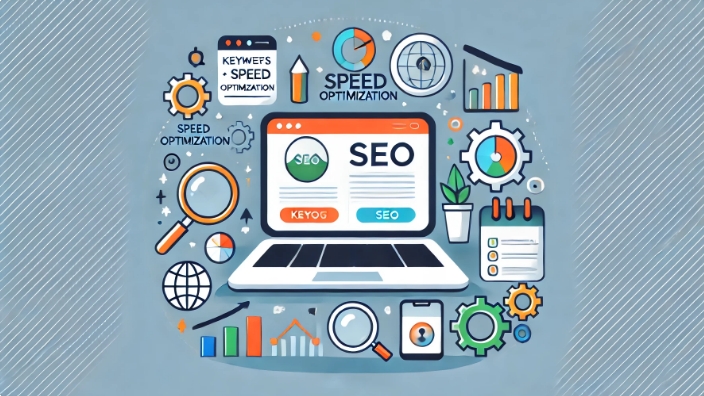In the world of digital marketing, search engine optimization (SEO) is crucial for driving organic traffic to your website and boosting your online visibility. For businesses just starting with SEO, implementing simple yet effective strategies can significantly impact search rankings, attract more visitors, and increase conversions. Here’s a guide to essential beginner-level SEO optimization methods that can help your website climb the search engine ranks and reach your target audience.
1. Start with Keyword Research
Effective SEO begins with thorough keyword research. Keywords are the words and phrases that users type into search engines to find information. Identifying the right keywords helps align your content with what your target audience is searching for. Tools like Google Keyword Planner, SEMrush, and Ahrefs provide insights into keyword volume, competition, and relevance.
Tips:
- Focus on long-tail keywords (phrases with 3+ words) for more specific search intent.
- Use keywords naturally in your content, titles, meta descriptions, and headers.
- Avoid “keyword stuffing” — overloading pages with keywords can harm your SEO.

2. Optimize Title Tags and Meta Descriptions
Title tags and meta descriptions are essential elements in on-page SEO. The title tag is the main headline that appears in search engine results, while the meta description is the short blurb below it. Crafting clear, compelling, and keyword-rich titles and descriptions can improve click-through rates and inform search engines about your page’s content.
Tips:
- Keep titles under 60 characters to ensure they display correctly on all devices.
- Write meta descriptions within 150-160 characters.
- Include relevant keywords in both, but focus on creating an engaging and informative message for users.
3. Create High-Quality Content
Content is king in SEO, especially when it is informative, valuable, and original. Search engines prioritize content that meets user needs, so creating blog posts, articles, and other resources can improve your ranking. Quality content also encourages users to spend more time on your site, which signals search engines that your site provides valuable information.
Tips:
- Aim for content that answers common questions or provides solutions.
- Use a mix of text, images, and videos to make content engaging.
- Regularly update content to keep it relevant and fresh.
4. Use Header Tags to Structure Content
Header tags (H1, H2, H3, etc.) organize your content and improve readability. Search engines use these tags to understand the hierarchy and main points of a page. Well-structured headers make it easier for both users and search engines to navigate your site.
Tips:
- Use only one H1 tag per page (usually the main title).
- Break content into sections with H2 and H3 tags to enhance readability.
- Include keywords in some headers to increase relevance.
5. Optimize Images with Alt Text
Images enhance content, but they also need to be optimized for SEO. Adding alt text to your images allows search engines to understand their content, improving your site’s accessibility and visibility in image search results.
Tips:
- Write concise, descriptive alt text that explains the image.
- Use keywords in alt text if it’s natural and relevant.
- Compress images to improve load times without compromising quality.
6. Improve Site Speed and Mobile Friendliness
Page speed and mobile-friendliness are critical factors in SEO. Users and search engines both prioritize fast, mobile-friendly sites. A slow-loading or non-responsive website can lead to high bounce rates, negatively affecting your rankings.
Tips:
- Use tools like Google PageSpeed Insights to test and optimize speed.
- Optimize images, reduce redirects, and leverage browser caching to enhance performance.
- Ensure your site uses a responsive design to provide a seamless experience on all devices.
7. Create a Sitemap and Submit to Search Engines
A sitemap is a roadmap of your website that tells search engines how to navigate your pages. Submitting a sitemap to Google and Bing allows search engines to index your site more efficiently, increasing the likelihood of ranking for your targeted keywords.
Tips:
- Generate a sitemap using tools like Yoast SEO or XML Sitemap Generator.
- Submit your sitemap in Google Search Console and Bing Webmaster Tools.
- Regularly update your sitemap as you add new pages and content.
8. Build Internal Links
Internal linking connects related pages within your website, making it easier for users to explore more content and for search engines to understand your site’s structure. Well-planned internal links can boost the SEO value of specific pages by directing link equity across your site.
Tips:
- Link to relevant content that complements the information on the current page.
- Use descriptive anchor text that includes keywords when possible.
- Avoid overloading a page with too many internal links — aim for quality over quantity.
Conclusion
Optimizing a website for search engines may seem challenging at first, but by implementing these beginner-friendly techniques, you can create a solid foundation for your website’s SEO success. From keyword research to content creation and technical optimizations, each of these steps plays an important role in improving your site’s visibility and search rankings. At WebDesignHub, we’re here to help with all your SEO needs, ensuring that your site is optimized for both search engines and users. Ready to take your website’s SEO to the next level? Contact us to learn more about our SEO services and web development solutions tailored to your business.

发表回复